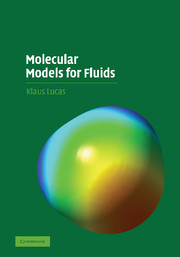Book contents
- Frontmatter
- Contents
- Nomenclature
- Preface
- 1 Introduction
- 2 Foundations
- 3 The Ideal Gas
- 4 Excess Function Models
- 5 Equation of State Models
- Appendix 1 Fundamental Constants and Atomic Units
- Appendix 2 Stirling's Formula
- Appendix 3 Relative Probability of a Microstate
- Appendix 4 Spherical Harmonics, Rotation Matrices, and Clebsch–Gordan Coefficients
- Appendix 5 Higher-Order Perturbation Terms for the Intermolecular Potential Energy of Simple Molecules
- Appendix 6 Rules for Integration
- Appendix 7 Internal Rotation Contributions
- Appendix 8 Quasichemical Approximation for the Degeneracy in a Lattice
- Appendix 9 Off-Lattice Formulation of the Quasichemical Approximation
- Appendix 10 Combinatorial Contribution to the Excess Entropy in a Lattice
- Appendix 11 Integration Variables for Three-Body Interactions
- Appendix 12 Multipole Perturbation Terms for the High-Temperature Expansion
- Index
4 - Excess Function Models
Published online by Cambridge University Press: 11 March 2010
- Frontmatter
- Contents
- Nomenclature
- Preface
- 1 Introduction
- 2 Foundations
- 3 The Ideal Gas
- 4 Excess Function Models
- 5 Equation of State Models
- Appendix 1 Fundamental Constants and Atomic Units
- Appendix 2 Stirling's Formula
- Appendix 3 Relative Probability of a Microstate
- Appendix 4 Spherical Harmonics, Rotation Matrices, and Clebsch–Gordan Coefficients
- Appendix 5 Higher-Order Perturbation Terms for the Intermolecular Potential Energy of Simple Molecules
- Appendix 6 Rules for Integration
- Appendix 7 Internal Rotation Contributions
- Appendix 8 Quasichemical Approximation for the Degeneracy in a Lattice
- Appendix 9 Off-Lattice Formulation of the Quasichemical Approximation
- Appendix 10 Combinatorial Contribution to the Excess Entropy in a Lattice
- Appendix 11 Integration Variables for Three-Body Interactions
- Appendix 12 Multipole Perturbation Terms for the High-Temperature Expansion
- Index
Summary
The fluid phase behavior of dense fluids, e.g., liquids, is not described adequately by the ideal gas molecular model. Thus, our interest now turns to configurational properties, i.e., those that are determined by the intermolecular potential energy. It is this potential energy that controls the most important aspects of fluid phase behavior, such as phase equilibria, and reaction equilibria in solutions.
A particularly simple approach to fluid phase behavior of dense fluids is offered by excess function models. The thermodynamic relations for computing phase and reaction equilibria as well as heat effects from excess functions are well established; cf. Section 2.1. They are basically rather straightforward and even allow evaluation by hand in many simple applications. The excess function approach is particularly suited to liquid mixtures made up of large molecules. The fluid phase behavior of such fluids tends to be interesting only over a narrow liquid density range at normal pressure, such that it may be formulated in terms of constant density and constant pressure mixing effects. Such effects are adequately formulated in terms of excess functions. Restriction to excess functions for liquid mixtures implies two important simplifications in the molecular models. First, we will not need explicit potential models over a large range of intermolecular distances and orientations. Because the molecules in liquids can be considered to be densely packed, the interactions between them can be modeled by contact energies of nearest neighbors. In this sense the potential model adequate for excess functions is the strict opposite to that of an ideal gas, where the distance between interacting molecules was assumed to be infinite.
- Type
- Chapter
- Information
- Molecular Models for Fluids , pp. 191 - 259Publisher: Cambridge University PressPrint publication year: 2007



